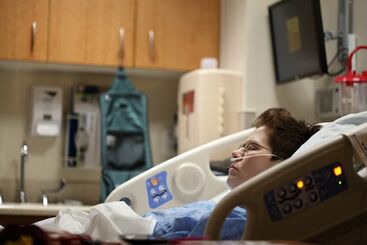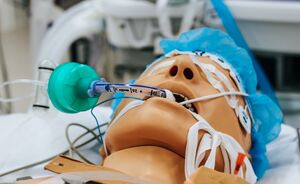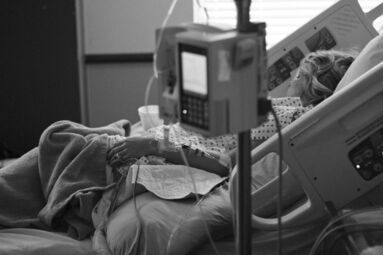Sedation in Critically-Ill Patients: Difference between revisions
Karen Wilson (talk | contribs) No edit summary |
No edit summary |
||
| (11 intermediate revisions by 2 users not shown) | |||
| Line 3: | Line 3: | ||
== Introduction == | == Introduction == | ||
ICU | [[File:Sedation ICU.jpeg|thumb|367x367px|Sedation, ICU]] | ||
Critical care is full of potential stressors. A review by Walder et al.<ref name=":0">Walder B, Tramèr MR. [https://scholar.google.com/scholar_url?url=https://smw.ch/journalfile/download/article/ezm_smw/en/smw.2004.10319/3ab7a364f5e1a7a38078a220c1b2b77a320e6e3f/smw.2004.10319.pdf/rsrc/jf&hl=en&sa=T&oi=gsb-gga&ct=res&cd=0&d=13544742134038491613&ei=Y-kuX9 Analgesia and sedation in critically ill patients]. Swiss medical weekly. 2004 Jun 12;134(23-24):333-46.</ref> found that up to 71% of critically-ill patients experience agitation, confusion, and anxiety during their ICU stay. | |||
* Common stressors include: [[Pain Assessment|pain]]; [[Sleep Deprivation and Sleep Disorders|sleeplessness]]; [[Ventilation and Weaning|mechanical ventilation]]; tubes in the nose and mouth; [[Intravenous Lines|intravenous lines]]; genitourinary catheters; noise; hallucinations; discomfort due to medical procedures; thoughts of death, and uncertainty.<ref name=":0" /><ref name=":1">Topçu S, Ecevit Alpar Ş, Gülseven B, Kebapçı A. [https://pxjournal.org/cgi/viewcontent.cgi?article=1137&context=journal Patient experiences in intensive care units: a systematic review]. Patient Experience Journal. 2017;4(3):115-27.</ref> | |||
* Left untreated, inadequate sedation can lead to: unplanned extubation; pulmonary and cardiac complications; increased time on mechanical ventilation; prolonged ICU stay.<ref name=":0" /><ref>Jaber S, Chanques G, Altairac C, Sebbane M, Vergne C, Perrigault PF, Eledjam JJ. [https://www.sciencedirect.com/science/article/abs/pii/S0012369215526998 A prospective study of agitation in a medical-surgical ICU: incidence, risk factors, and outcomes]. Chest. 2005 Oct 1;128(4):2749-57. [abstract only]</ref> | |||
As a result, use of sedative agents is common to enhance patient comfort, facilitate therapeutic procedures, and avoid preventable complications. | |||
== Definitions == | == Definitions == | ||
Sedation | Sedation refers to the reduction of anxiety, stress, irritability, or excitement via administration of a sedative drugs.<ref>Wordnik [https://www.wordnik.com/words/sedation Sedation] Available:https://www.wordnik.com/words/sedation (accessed 27.12.2022)</ref> Sedative's actions involves increasing the neurotransmitter gamma-aminobutyric acid ([[GABA]]) within brain. GABAs role is to slow down the transmission of the brains signals.<ref>Study.com [https://study.com/learn/lesson/sedative-drug-overview-types.html What are Sedative Drugs?] Available:https://study.com/learn/lesson/sedative-drug-overview-types.html (accessed 27.12.2022)</ref> | ||
Sedative agents are associated with the following effects: | |||
* Anxiolysis- relief of [[Generalized Anxiety Disorder|anxiety]], [[Stress and Health|stress]], or agitation | |||
* Analgesia- [[Pain Medications|relief of pain]] | |||
* Anesthesia- loss of [[sensation]] | |||
* Amnesia- l[[Disorders of Consciousness|oss of memory for a block of time]]<ref name=":2">Nickson, C. Sedation in the ICU. Last updated March 30, 2019. Accessed 8 August 2020 at https://litfl.com/sedation-in-icu/</ref> | |||
== Depth of Sedation == | == Depth of Sedation == | ||
Dosing can alter the effect of sedative agents.<ref name=":2" /> At minimal levels, sedation may only have an anxiolytic effect. At deeper levels of sedation, responsiveness, airway reflexes, and spontaneous ventilation are impacted. Table 1 summarizes the different levels of sedation seen in critical care.<ref name=":2" /> | [[File:Coma, model.jpeg|thumb|In need of deep sedation]] | ||
Dosing can alter the effect of sedative agents.<ref name=":2" /> | |||
* At minimal levels, sedation may only have an anxiolytic effect. | |||
* At deeper levels of sedation, responsiveness, airway reflexes, and spontaneous ventilation are impacted. | |||
Table 1 summarizes the different levels of sedation seen in critical care.<ref name=":2" /> | |||
'''Table 1. Depth of Sedation''' | '''Table 1. Depth of Sedation''' | ||
| Line 24: | Line 38: | ||
|- | |- | ||
|Moderate sedation | |Moderate sedation | ||
|Responsive to tactile or verbal stimuli (verbal or tactile); cardiovascular function, spontaneous ventilation, and airway reflexes are maintained. | |Responsive to tactile or verbal stimuli (verbal or tactile); [[Cardiovascular System|cardiovascular]] function, spontaneous ventilation, and airway reflexes are maintained. | ||
|- | |- | ||
|Deep sedation | |Deep sedation | ||
| Line 31: | Line 45: | ||
== Indications == | == Indications == | ||
There are numerous indications for sedation. In most cases, a minimal sedation protocol is used to help patients remain “calm, lucid, pain-free, interactive, and cooperative with their care.”<ref name=":3">Reade MC, Finfer S. [https://www.nejm.org/doi/full/10.1056/NEJMra1208705 Sedation and delirium in the intensive care unit]. New England Journal of Medicine. 2014 Jan 30;370(5):444-54.</ref> Deep sedation is only warranted under select circumstances. Table 2 contains a non-exhaustive list of indications for minimal and deep sedation.<ref name=":1" /><ref name=":3" /><ref name=":4">Makii JM, Mirski MA, Lewin III JJ. [https://dolor.org.co/biblioteca/articulos/Sedation and Analgesia in Critically Ill Neurologic Patients.pdf Sedation and analgesia in critically ill neurologic patients]. Journal of pharmacy practice. 2010 Oct;23(5):455-69.</ref> | There are numerous indications for sedation. | ||
* In most cases, a minimal sedation protocol is used to help patients remain “calm, lucid, pain-free, interactive, and cooperative with their care.”<ref name=":3">Reade MC, Finfer S. [https://www.nejm.org/doi/full/10.1056/NEJMra1208705 Sedation and delirium in the intensive care unit]. New England Journal of Medicine. 2014 Jan 30;370(5):444-54.</ref> | |||
* Deep sedation is only warranted under select circumstances. Table 2 contains a non-exhaustive list of indications for minimal and deep sedation.<ref name=":1" /><ref name=":3" /><ref name=":4">Makii JM, Mirski MA, Lewin III JJ. [https://dolor.org.co/biblioteca/articulos/Sedation and Analgesia in Critically Ill Neurologic Patients.pdf Sedation and analgesia in critically ill neurologic patients]. Journal of pharmacy practice. 2010 Oct;23(5):455-69.</ref> | |||
'''Table 2. Indications by Sedation Protocol''' | '''Table 2. Indications by Sedation Protocol''' | ||
| Line 43: | Line 60: | ||
* Decrease anxiety | * Decrease anxiety | ||
* Increase tolerance for ventilator support | * Increase tolerance for ventilator support | ||
* Facilitate nurse/doctor interventions such as aspiration and dressing changes | * Facilitate nurse/doctor interventions such as [[Suctioning|aspiration]] and dressing changes | ||
* Improve patient comfort | * Improve patient comfort | ||
|- | |- | ||
| Line 49: | Line 66: | ||
| | | | ||
* Treatment of specific medical conditions including: | * Treatment of specific medical conditions including: | ||
** intracranial hypertension, | ** intracranial hypertension, | ||
** severe respiratory failure, | ** severe [[Respiratory Failure|respiratory failure]], | ||
** refractory status epilepticus, | ** refractory status [[Epilepsy|epilepticus]], | ||
** | ** prevention of awareness in patients treated with neuromuscular blocking agents. | ||
|} | |} | ||
== Commonly Used Sedative Agents == | == Commonly Used Sedative Agents == | ||
Sedative therapy can be managed using a variety of drug agents:<ref name=":0" /><ref name=":3" /> | Analgesics and sedatives are used to allow patients to tolerate nursing actions and tracheal intubation and to aid mechanical ventilation. Sedative therapy can be managed using a variety of drug agents, including:<ref name=":0" /><ref name=":3" /> | ||
* Benzodiazepines (midazolam, lorazepam, diazepam) | * [[Benzodiazepines in the Treatment of Spinal Cord Injuries|Benzodiazepine]]<nowiki/>s (midazolam, lorazepam, diazepam), midazolam and lorazepam tend to be used for medium- and long-term use.<ref name=":0" /><ref name=":3" /><ref name=":4" /> | ||
* Ketamine | * Ketamine | ||
* Propofol | * Propofol (often favored for short-term sedation and ventilator weaning).<ref name=":0" /><ref name=":3" /><ref name=":4" /> | ||
* Isoflurane | * Isoflurane | ||
* Chloral derivatives | * Chloral derivatives | ||
* Barbiturates (have largely been replaced by alternatives) | * Barbiturates (have largely been replaced by alternatives) | ||
* Centrally acting alpha-2 agonists (clonidine, dexmedetomidine | * Centrally acting alpha-2 agonists (decrease sympathetic nervous system activity) eg clonidine, dexmedetomidine. Dexmedetomidine is useful for minimizing the risk of delirium and maintaining patient interactivity under light sedation. | ||
* Clomethizole, | * Clomethizole, | ||
* Neuroleptics (droperidol, | * Neuroleptics (droperidol, haloperidol) | ||
Analgosedation agents: may also used for sedative therapy. Early research suggests that analgosedation agents, particularly Remifentanil, may reduce sedative requirements, reduce ventilator time, and decrease ICU length of stay when used as first-line treatment for light sedation.<ref name=":0" /><ref name=":3" /><ref name=":5">Devabhakthuni S, Armahizer MJ, Dasta JF, Kane-Gill SL. [https://www.researchgate.net/profile/Sandeep_Devabhakthuni/publication/223977738_Analgosedation_A_Paradigm_Shift_in_Intensive_Care_Unit_Sedation_Practice/links/00b495298c0f13ff3d000000.pdf Analgosedation: a paradigm shift in intensive care unit sedation practice]. Annals of Pharmacotherapy. 2012 Apr;46(4):530-40.</ref> These agents are pain relieving drugs with a sedative effect and include: | |||
* Fentanyl | * Fentanyl | ||
* Remifentanil | * Remifentanil | ||
* Morphine | * Morphine | ||
== Negative Side Effects == | == Negative Side Effects == | ||
The negative side effects of pharmacological sedation vary by agent. The general side effects of sedatives include the following: | The negative side effects of pharmacological sedation vary by agent. The general side effects of sedatives include the following: [[Hypotension]]; Respiratory depression; [[Heart Arrhythmias|Heart arrhythmias]]; Withdrawal; [[ICU Delirium|Delirium]]; [[Sleep Deprivation and Sleep Disorders|Sleep disturbance]]; Toxicity.<ref name=":2" /><ref name=":5" /> | ||
Benzodiazepines are associated with an increased risk of [[ICU Delirium|delirium]], increased time on mechanical ventilation, and prolonged ICU stay.<ref name=":0" /> | |||
== Assessment and Monitoring == | == Assessment and Monitoring == | ||
[[File:Man in coma.jpeg|thumb|Man in coma, ICU]] | |||
Regular assessment of sedation and agitation are important for ensuring adequate patient arousal. Consistent monitoring likely reduces over-sedation, the use of unnecessary imaging to assess patients’ neurological status, and negative patient outcomes.<ref name=":0" /> Below are common scales used to measure sedation and agitation: | Regular assessment of sedation and agitation are important for ensuring adequate patient arousal. Consistent monitoring likely reduces over-sedation, the use of unnecessary imaging to assess patients’ neurological status, and negative patient outcomes.<ref name=":0" /> Below are common scales used to measure sedation and agitation: | ||
* [[Richmond Agitation-Sedation Scale (RASS)|Richmond Agitation-Sedation Scale]] (RASS) | * [[Richmond Agitation-Sedation Scale (RASS)|Richmond Agitation-Sedation Scale]] (RASS) | ||
| Line 101: | Line 101: | ||
* Ramsay Sedation Scale (RSS) | * Ramsay Sedation Scale (RSS) | ||
== | == Protocols == | ||
[[File:Sedationicu-hospitalpatient.jpg|Sediation|alt=|thumb|383x383px]]Sedation protocols should be standard in ICU, and followed by staff. These protocols need to be regularly updated.<ref name=":7" /> | |||
PADIS guidelines (developed to help ensure consistent, evidence-based care of critical care patients utilising the most up-to-date, relevant knowledge available)<ref>SCCM.org [https://www.sccm.org/ICULiberation/News/Hot-off-the-Press-New-PADIS-Guideline 2018 PADIS Guideline] Available:https://www.sccm.org/ICULiberation/News/Hot-off-the-Press-New-PADIS-Guideline (accessed 27.12.2022)</ref> recommend the following: | |||
* | |||
* | * Depth of sedation be monitored regularly with a valid and reliable subjective scale. | ||
* If a subjective scale cannot be used, (eg in deep sedation or neuromuscular blockade), Bispectral Index (BIS) monitoring is best suited for guiding titration. | |||
* In critically ill, mechanically ventilated patients, propofol or dexmedetomidine should be used over benzodiazepines to minimize delirium. | * In critically ill, mechanically ventilated patients, propofol or dexmedetomidine should be used over benzodiazepines to minimize delirium. | ||
* When possible, sedation should be minimized using daily awakening trials or continuous monitoring with light sedation targets. | * When possible, sedation should be minimized using daily awakening trials or continuous monitoring with light sedation targets<ref name=":6">Devlin JW, Skrobik Y, Gélinas C, Needham DM, Slooter AJ, Pandharipande PP, Watson PL, Weinhouse GL, Nunnally ME, Rochwerg B, Balas MC. [https://escholarship.org/content/qt7rx6v813/qt7rx6v813.pdf Clinical practice guidelines for the prevention and management of pain, agitation/sedation, delirium, immobility, and sleep disruption in adult patients in the ICU]. Critical care medicine. 2018 Sep 1;46(9):e825-73.</ref>. | ||
These guidelines and ongoing research acknowledge two areas in need of further investigation:<ref name=":4" /><ref name=":5" /><ref name=":6" /> | These guidelines and ongoing research acknowledge two areas in need of further investigation:<ref name=":4" /><ref name=":5" /><ref name=":6" /> | ||
# Sedative choice in terms of analgosedation, and | # Sedative choice in terms of analgosedation, and | ||
# Sedative choice for certain patient subgroups (ex. patients who are hemodynamically unstable, have neurological injuries, extensive burns, and/or [[Coronavirus Disease (COVID-19)|COVID-19]] infection) | # Sedative choice for certain patient subgroups (ex. patients who are hemodynamically unstable, have neurological injuries, extensive burns, and/or [[Coronavirus Disease (COVID-19)|COVID-19]] infection) | ||
Ongoing challenges include the adoption of up-to-date sedation guidelines by facilities.<ref>Tallgren M, Pettilä V, Hynninen M. [https://onlinelibrary.wiley.com/doi/abs/10.1111/j.1399-6576.2006.01094.x Quality assessment of sedation in intensive care]. Acta anaesthesiologica scandinavica. 2006 Sep;50(8):942-6. (abstract only)</ref><ref>Arroyo-Novoa CM, Figueroa-Ramos MI, Puntillo KA. [https://www.ncbi.nlm.nih.gov/pmc/articles/PMC6906604/pdf/nihms-1061877.pdf Occurrence and practices for pain, agitation, and delirium in intensive care unit patients]. Puerto Rico health sciences journal. 2019 Sep;38(3):156.</ref> | |||
== Sedation Vacations == | |||
Pharmacological sedation in the ICU is evolving. Traditionally, patients who were mechanically ventilated in the ICU were kept deeply sedated aiming for continuous depressant infusions to help with ventilation and decrease discomfort that may occur during critical illness. Data from early 2000's suggested that continuous infusions of sedative medications made for worse clinical outcomes.<ref>Mayo Clinic [https://www.mayoclinic.org/medical-professionals/pulmonary-medicine/news/update-on-icu-sedation/mac-20483374 Update on ICU sedation] Available: https://www.mayoclinic.org/medical-professionals/pulmonary-medicine/news/update-on-icu-sedation/mac-20483374<nowiki/>(accessed 27.12.2022)</ref> | |||
# Sedation vacations involves ceasing the sedative infusions, allowing the patient to wake. The infusion is restarted only when the patient is fully awake and obeying commands or until they became uncomfortable/agitated and require restarting sedation (ideally performed on a daily basis). This strategy: reduces the duration of mechanical ventilation; decreases length of stay in ICU.<ref name=":7">Rowe K, Fletcher S. [https://academic.oup.com/bjaed/article/8/2/50/338650?login=false Sedation in the intensive care unit.] Continuing education in anaesthesia, critical care and pain. 2008 Apr 1;8(2):50-5. Available:https://academic.oup.com/bjaed/article/8/2/50/338650?login=false (accessed 27.12.2022)</ref> | |||
# Sedation vacations are a balancing act of carefully titrating the sedative dose to provide agitation-free, comfortable sedation at the lowest dosage viable<ref>Sharma S, Hashmi MF, Valentino III DJ. [https://www.ncbi.nlm.nih.gov/books/NBK513327/ Sedation Vacation in the ICU].Available:https://www.ncbi.nlm.nih.gov/books/NBK513327/ (accessed 26.12.2022)</ref> | |||
== Physical Therapy Implications == | == Physical Therapy Implications == | ||
[[File:Hospital-staff.jpeg|thumb|376x376px|Physiotherapist reading charts ]] | |||
To endure patient a multidisciplinary approach (in addition to pharmacotherapy) is needed. Physiotherapy plays an important role as prolonged immobility may be painful and this can be reduced by daily assessment and treatment.<ref name=":7" /> | |||
When treating those sedated in ICU knowledge of sedative agents, depths of sedation, sedation protocols, and tools for assessment are critical. They help with gauging patient readiness for skilled therapy intervention and [[Early Mobilization in the ICU|early mobility in ICU]], and communicating with other professionals in the ICU. | |||
Physical therapists also engage in non-pharmacological means of reducing patient anxiety and agitation to minimize the need for sedative agents. Strategies may include:<ref name=":1" /> | |||
* Making explanations to patients before performing any interventions | * Making explanations to patients before performing any interventions | ||
* Providing frequent orientation and reassurance | * Providing frequent orientation and reassurance | ||
Latest revision as of 09:41, 27 December 2022
Introduction[edit | edit source]
Critical care is full of potential stressors. A review by Walder et al.[1] found that up to 71% of critically-ill patients experience agitation, confusion, and anxiety during their ICU stay.
- Common stressors include: pain; sleeplessness; mechanical ventilation; tubes in the nose and mouth; intravenous lines; genitourinary catheters; noise; hallucinations; discomfort due to medical procedures; thoughts of death, and uncertainty.[1][2]
- Left untreated, inadequate sedation can lead to: unplanned extubation; pulmonary and cardiac complications; increased time on mechanical ventilation; prolonged ICU stay.[1][3]
As a result, use of sedative agents is common to enhance patient comfort, facilitate therapeutic procedures, and avoid preventable complications.
Definitions[edit | edit source]
Sedation refers to the reduction of anxiety, stress, irritability, or excitement via administration of a sedative drugs.[4] Sedative's actions involves increasing the neurotransmitter gamma-aminobutyric acid (GABA) within brain. GABAs role is to slow down the transmission of the brains signals.[5]
Sedative agents are associated with the following effects:
- Anxiolysis- relief of anxiety, stress, or agitation
- Analgesia- relief of pain
- Anesthesia- loss of sensation
- Amnesia- loss of memory for a block of time[6]
Depth of Sedation[edit | edit source]
Dosing can alter the effect of sedative agents.[6]
- At minimal levels, sedation may only have an anxiolytic effect.
- At deeper levels of sedation, responsiveness, airway reflexes, and spontaneous ventilation are impacted.
Table 1 summarizes the different levels of sedation seen in critical care.[6]
Table 1. Depth of Sedation
| Depth | Description |
|---|---|
| Minimal or light sedation | Relief of anxiety or agitation (anxiolysis) only |
| Moderate sedation | Responsive to tactile or verbal stimuli (verbal or tactile); cardiovascular function, spontaneous ventilation, and airway reflexes are maintained. |
| Deep sedation | Purposefully responsive to painful or repeated stimuli; spontaneous ventilation or airway reflexes may not be maintained, however cardiovascular function is preserved. |
Indications[edit | edit source]
There are numerous indications for sedation.
- In most cases, a minimal sedation protocol is used to help patients remain “calm, lucid, pain-free, interactive, and cooperative with their care.”[7]
- Deep sedation is only warranted under select circumstances. Table 2 contains a non-exhaustive list of indications for minimal and deep sedation.[2][7][8]
Table 2. Indications by Sedation Protocol
| Sedation Protocol | Indications |
|---|---|
| Minimal sedation |
|
| Deep sedation |
|
Commonly Used Sedative Agents[edit | edit source]
Analgesics and sedatives are used to allow patients to tolerate nursing actions and tracheal intubation and to aid mechanical ventilation. Sedative therapy can be managed using a variety of drug agents, including:[1][7]
- Benzodiazepines (midazolam, lorazepam, diazepam), midazolam and lorazepam tend to be used for medium- and long-term use.[1][7][8]
- Ketamine
- Propofol (often favored for short-term sedation and ventilator weaning).[1][7][8]
- Isoflurane
- Chloral derivatives
- Barbiturates (have largely been replaced by alternatives)
- Centrally acting alpha-2 agonists (decrease sympathetic nervous system activity) eg clonidine, dexmedetomidine. Dexmedetomidine is useful for minimizing the risk of delirium and maintaining patient interactivity under light sedation.
- Clomethizole,
- Neuroleptics (droperidol, haloperidol)
Analgosedation agents: may also used for sedative therapy. Early research suggests that analgosedation agents, particularly Remifentanil, may reduce sedative requirements, reduce ventilator time, and decrease ICU length of stay when used as first-line treatment for light sedation.[1][7][9] These agents are pain relieving drugs with a sedative effect and include:
- Fentanyl
- Remifentanil
- Morphine
Negative Side Effects[edit | edit source]
The negative side effects of pharmacological sedation vary by agent. The general side effects of sedatives include the following: Hypotension; Respiratory depression; Heart arrhythmias; Withdrawal; Delirium; Sleep disturbance; Toxicity.[6][9]
Benzodiazepines are associated with an increased risk of delirium, increased time on mechanical ventilation, and prolonged ICU stay.[1]
Assessment and Monitoring[edit | edit source]
Regular assessment of sedation and agitation are important for ensuring adequate patient arousal. Consistent monitoring likely reduces over-sedation, the use of unnecessary imaging to assess patients’ neurological status, and negative patient outcomes.[1] Below are common scales used to measure sedation and agitation:
- Richmond Agitation-Sedation Scale (RASS)
- Riker Sedation-Agitation Scale (SAS)
- Ramsay Sedation Scale (RSS)
Protocols[edit | edit source]
Sedation protocols should be standard in ICU, and followed by staff. These protocols need to be regularly updated.[10]
PADIS guidelines (developed to help ensure consistent, evidence-based care of critical care patients utilising the most up-to-date, relevant knowledge available)[11] recommend the following:
- Depth of sedation be monitored regularly with a valid and reliable subjective scale.
- If a subjective scale cannot be used, (eg in deep sedation or neuromuscular blockade), Bispectral Index (BIS) monitoring is best suited for guiding titration.
- In critically ill, mechanically ventilated patients, propofol or dexmedetomidine should be used over benzodiazepines to minimize delirium.
- When possible, sedation should be minimized using daily awakening trials or continuous monitoring with light sedation targets[12].
These guidelines and ongoing research acknowledge two areas in need of further investigation:[8][9][12]
- Sedative choice in terms of analgosedation, and
- Sedative choice for certain patient subgroups (ex. patients who are hemodynamically unstable, have neurological injuries, extensive burns, and/or COVID-19 infection)
Ongoing challenges include the adoption of up-to-date sedation guidelines by facilities.[13][14]
Sedation Vacations[edit | edit source]
Pharmacological sedation in the ICU is evolving. Traditionally, patients who were mechanically ventilated in the ICU were kept deeply sedated aiming for continuous depressant infusions to help with ventilation and decrease discomfort that may occur during critical illness. Data from early 2000's suggested that continuous infusions of sedative medications made for worse clinical outcomes.[15]
- Sedation vacations involves ceasing the sedative infusions, allowing the patient to wake. The infusion is restarted only when the patient is fully awake and obeying commands or until they became uncomfortable/agitated and require restarting sedation (ideally performed on a daily basis). This strategy: reduces the duration of mechanical ventilation; decreases length of stay in ICU.[10]
- Sedation vacations are a balancing act of carefully titrating the sedative dose to provide agitation-free, comfortable sedation at the lowest dosage viable[16]
Physical Therapy Implications[edit | edit source]
To endure patient a multidisciplinary approach (in addition to pharmacotherapy) is needed. Physiotherapy plays an important role as prolonged immobility may be painful and this can be reduced by daily assessment and treatment.[10]
When treating those sedated in ICU knowledge of sedative agents, depths of sedation, sedation protocols, and tools for assessment are critical. They help with gauging patient readiness for skilled therapy intervention and early mobility in ICU, and communicating with other professionals in the ICU.
Physical therapists also engage in non-pharmacological means of reducing patient anxiety and agitation to minimize the need for sedative agents. Strategies may include:[2]
- Making explanations to patients before performing any interventions
- Providing frequent orientation and reassurance
- Using alternative means of communication for non-verbal patients (ex. writing, communication boards)
- Trying to identify and eliminate causes of pain
- Coordinating analgesic administration with therapy sessions
- Repositioning for comfort
- Frequently cleaning oral secretions
- Regularly checking the location and fixation of lines and tubes
References[edit | edit source]
- ↑ 1.0 1.1 1.2 1.3 1.4 1.5 1.6 1.7 1.8 Walder B, Tramèr MR. Analgesia and sedation in critically ill patients. Swiss medical weekly. 2004 Jun 12;134(23-24):333-46.
- ↑ 2.0 2.1 2.2 Topçu S, Ecevit Alpar Ş, Gülseven B, Kebapçı A. Patient experiences in intensive care units: a systematic review. Patient Experience Journal. 2017;4(3):115-27.
- ↑ Jaber S, Chanques G, Altairac C, Sebbane M, Vergne C, Perrigault PF, Eledjam JJ. A prospective study of agitation in a medical-surgical ICU: incidence, risk factors, and outcomes. Chest. 2005 Oct 1;128(4):2749-57. [abstract only]
- ↑ Wordnik Sedation Available:https://www.wordnik.com/words/sedation (accessed 27.12.2022)
- ↑ Study.com What are Sedative Drugs? Available:https://study.com/learn/lesson/sedative-drug-overview-types.html (accessed 27.12.2022)
- ↑ 6.0 6.1 6.2 6.3 Nickson, C. Sedation in the ICU. Last updated March 30, 2019. Accessed 8 August 2020 at https://litfl.com/sedation-in-icu/
- ↑ 7.0 7.1 7.2 7.3 7.4 7.5 Reade MC, Finfer S. Sedation and delirium in the intensive care unit. New England Journal of Medicine. 2014 Jan 30;370(5):444-54.
- ↑ 8.0 8.1 8.2 8.3 Makii JM, Mirski MA, Lewin III JJ. Sedation and analgesia in critically ill neurologic patients. Journal of pharmacy practice. 2010 Oct;23(5):455-69.
- ↑ 9.0 9.1 9.2 Devabhakthuni S, Armahizer MJ, Dasta JF, Kane-Gill SL. Analgosedation: a paradigm shift in intensive care unit sedation practice. Annals of Pharmacotherapy. 2012 Apr;46(4):530-40.
- ↑ 10.0 10.1 10.2 Rowe K, Fletcher S. Sedation in the intensive care unit. Continuing education in anaesthesia, critical care and pain. 2008 Apr 1;8(2):50-5. Available:https://academic.oup.com/bjaed/article/8/2/50/338650?login=false (accessed 27.12.2022)
- ↑ SCCM.org 2018 PADIS Guideline Available:https://www.sccm.org/ICULiberation/News/Hot-off-the-Press-New-PADIS-Guideline (accessed 27.12.2022)
- ↑ 12.0 12.1 Devlin JW, Skrobik Y, Gélinas C, Needham DM, Slooter AJ, Pandharipande PP, Watson PL, Weinhouse GL, Nunnally ME, Rochwerg B, Balas MC. Clinical practice guidelines for the prevention and management of pain, agitation/sedation, delirium, immobility, and sleep disruption in adult patients in the ICU. Critical care medicine. 2018 Sep 1;46(9):e825-73.
- ↑ Tallgren M, Pettilä V, Hynninen M. Quality assessment of sedation in intensive care. Acta anaesthesiologica scandinavica. 2006 Sep;50(8):942-6. (abstract only)
- ↑ Arroyo-Novoa CM, Figueroa-Ramos MI, Puntillo KA. Occurrence and practices for pain, agitation, and delirium in intensive care unit patients. Puerto Rico health sciences journal. 2019 Sep;38(3):156.
- ↑ Mayo Clinic Update on ICU sedation Available: https://www.mayoclinic.org/medical-professionals/pulmonary-medicine/news/update-on-icu-sedation/mac-20483374(accessed 27.12.2022)
- ↑ Sharma S, Hashmi MF, Valentino III DJ. Sedation Vacation in the ICU.Available:https://www.ncbi.nlm.nih.gov/books/NBK513327/ (accessed 26.12.2022)











